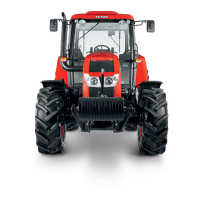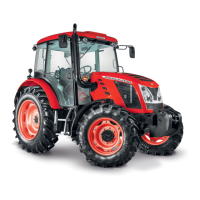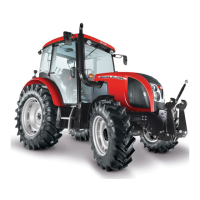Do you have a question about the Zetor PROXIMA PLUS 8541 and is the answer not in the manual?
General rules for safe tractor operation and compliance with local regulations.
Procedures and warnings for safely starting the tractor's engine.
Safety measures and warnings during tractor operation.
Warnings and guidelines for the tractor's electrical system and modifications.
Procedure to check the fuel system for leaks and repair them.
How to check and maintain the engine oil level using the dipstick.
Checking the cooling system for leaks and coolant level.
Checking brake and clutch fluid levels and for leaks.
Checking the hydrostatic steering oil level and hoses.
Checking tire inflation pressure and wheel bolt tightness.
Procedure for air cleaner maintenance based on the clogging indicator.
Checking hitches and attachments for good condition.
General guidelines for entering and exiting the tractor's safety cab.
Adjusting the driver's seat based on weight and positions.
Overview of the heating, AC, and radio control panel.
Ensuring proper heating and AC function by creating cab overpressure.
Overview of the tractor's dashboard instruments.
Explanation of the dashboard instruments like indicator lights and gauges.
Detailed explanation of various indicator lights on the dashboard.
Information on the optional digital dashboard features and operation.
How indicator lights and push buttons function on the digital dashboard.
Identification and function of various switches on the tractor.
Information on the ignition lock and key positions.
Pre-start checks for the tractor to ensure safety and proper condition.
Step-by-step procedure for starting the tractor engine.
Troubleshooting steps if the engine fails to start.
Proper handling and precautions for the starter motor.
Recommended actions and checks immediately after engine start.
Proper procedures for preheating the engine, especially in cold conditions.
General principles of tractor gear shifting.
Using the reversing lever to select forward or reverse drive.
Shifting between road and reduced gear ranges.
Correct procedure for shifting to higher gears.
Correct procedure for shifting to lower gears.
Function and operation of the torque multiplier.
Step-by-step guide to setting the tractor in motion.
Precautions and techniques for driving uphill to avoid overloading.
Safety measures and gear selection for driving downhill.
How and when to use the differential lock.
Controlling the front driving axle engagement.
Guidelines for driving with the front axle engaged.
Description of the tractor's service brake system.
Operation of air brakes for trailers and semi-trailers.
Operation of hydraulic trailer brake systems.
How to safely stop and engage the parking brake.
Correct procedure for stopping the tractor engine.
Steps to follow when leaving the tractor unattended.
Critical notification regarding malfunction warning lights.
General guidelines for the initial 100 operating hours of a new tractor.
Table of maximum static loads for various hitch types.
General safety and operational guidelines for using the PTO shaft.
How to engage and disengage the front and rear PTO shafts.
Engaging dependent and independent PTO shaft speeds.
Shifting the rear PTO shaft between speed settings.
Specifications and options for the front PTO shaft.
Selecting control modes (P, M, D) for the three-point hitch.
Description of the rear three-point hitch and ISO categories.
Safety rules for working with the three-point hitch.
Description of the front three-point hitch for agricultural machines.
Essential service information regarding the accumulator battery and starting procedures.
Guidelines for keeping the accumulator battery clean and properly fixed.
Procedures for charging and maintaining the accumulator battery.
Location of the fuse box and a chart of fuses and their protected systems.
Comprehensive table detailing inspection and maintenance tasks at various operating hours.
Diagram and chart identifying lubrication points and recommended fillings.
Daily procedure for checking the engine oil level.
How to replace the engine oil filter cartridge.
Steps for replacing the fuel filter cartridge.
How to bleed the fuel system after filter replacement.
Daily procedure for checking hydrostatic steering oil level.
How to change oil and replace the filter in the hydrostatic steering.
Procedure for bleeding the hydrostatic steering hydraulic circuit.
Procedure for changing the tractor's coolant.
Checking oil levels and performing oil changes in transmission and axle housings.
How to refill brake fluid and daily checks.
Procedures and guidelines for inflating tractor tires.
Correct adjustment of play in the brake pedals.
General procedure for bleeding the tractor's brake system.
Steps to bleed the main brake valve for trailers.
Procedure for bleeding the rear wheel brake system.
How to bleed the front driving axle brake system.
Procedure for bleeding the hydraulic trailer brake system.
Checking and adjusting the service and parking brakes.
Specific steps for adjusting the service brake.
Steps for adjusting the parking brake.
Adjusting the free travel clearance of the clutch pedal.
How to bleed the hydraulic clutch circuit.
Technical data for the tractor's engine model.
Table showing maximum allowed front axle loads based on speed and wheelbase.
Table showing maximum allowed rear axle loads based on speed and wheelbase.
Maximum allowable combination weight for tractor and hitched implement.
General rules for safe tractor operation and compliance with local regulations.
Procedures and warnings for safely starting the tractor's engine.
Safety measures and warnings during tractor operation.
Warnings and guidelines for the tractor's electrical system and modifications.
Procedure to check the fuel system for leaks and repair them.
How to check and maintain the engine oil level using the dipstick.
Checking the cooling system for leaks and coolant level.
Checking brake and clutch fluid levels and for leaks.
Checking the hydrostatic steering oil level and hoses.
Checking tire inflation pressure and wheel bolt tightness.
Procedure for air cleaner maintenance based on the clogging indicator.
Checking hitches and attachments for good condition.
General guidelines for entering and exiting the tractor's safety cab.
Adjusting the driver's seat based on weight and positions.
Overview of the heating, AC, and radio control panel.
Ensuring proper heating and AC function by creating cab overpressure.
Overview of the tractor's dashboard instruments.
Explanation of the dashboard instruments like indicator lights and gauges.
Detailed explanation of various indicator lights on the dashboard.
Information on the optional digital dashboard features and operation.
How indicator lights and push buttons function on the digital dashboard.
Identification and function of various switches on the tractor.
Information on the ignition lock and key positions.
Pre-start checks for the tractor to ensure safety and proper condition.
Step-by-step procedure for starting the tractor engine.
Troubleshooting steps if the engine fails to start.
Proper handling and precautions for the starter motor.
Recommended actions and checks immediately after engine start.
Proper procedures for preheating the engine, especially in cold conditions.
General principles of tractor gear shifting.
Using the reversing lever to select forward or reverse drive.
Shifting between road and reduced gear ranges.
Correct procedure for shifting to higher gears.
Correct procedure for shifting to lower gears.
Function and operation of the torque multiplier.
Step-by-step guide to setting the tractor in motion.
Precautions and techniques for driving uphill to avoid overloading.
Safety measures and gear selection for driving downhill.
How and when to use the differential lock.
Controlling the front driving axle engagement.
Guidelines for driving with the front axle engaged.
Description of the tractor's service brake system.
Operation of air brakes for trailers and semi-trailers.
Operation of hydraulic trailer brake systems.
How to safely stop and engage the parking brake.
Correct procedure for stopping the tractor engine.
Steps to follow when leaving the tractor unattended.
Critical notification regarding malfunction warning lights.
General guidelines for the initial 100 operating hours of a new tractor.
Table of maximum static loads for various hitch types.
General safety and operational guidelines for using the PTO shaft.
How to engage and disengage the front and rear PTO shafts.
Engaging dependent and independent PTO shaft speeds.
Shifting the rear PTO shaft between speed settings.
Specifications and options for the front PTO shaft.
Selecting control modes (P, M, D) for the three-point hitch.
Description of the rear three-point hitch and ISO categories.
Safety rules for working with the three-point hitch.
Description of the front three-point hitch for agricultural machines.
Essential service information regarding the accumulator battery and starting procedures.
Guidelines for keeping the accumulator battery clean and properly fixed.
Procedures for charging and maintaining the accumulator battery.
Location of the fuse box and a chart of fuses and their protected systems.
Comprehensive table detailing inspection and maintenance tasks at various operating hours.
Diagram and chart identifying lubrication points and recommended fillings.
Daily procedure for checking the engine oil level.
How to replace the engine oil filter cartridge.
Steps for replacing the fuel filter cartridge.
How to bleed the fuel system after filter replacement.
Daily procedure for checking hydrostatic steering oil level.
How to change oil and replace the filter in the hydrostatic steering.
Procedure for bleeding the hydrostatic steering hydraulic circuit.
Procedure for changing the tractor's coolant.
Checking oil levels and performing oil changes in transmission and axle housings.
How to refill brake fluid and daily checks.
Procedures and guidelines for inflating tractor tires.
Correct adjustment of play in the brake pedals.
General procedure for bleeding the tractor's brake system.
Steps to bleed the main brake valve for trailers.
Procedure for bleeding the rear wheel brake system.
How to bleed the front driving axle brake system.
Procedure for bleeding the hydraulic trailer brake system.
Checking and adjusting the service and parking brakes.
Specific steps for adjusting the service brake.
Steps for adjusting the parking brake.
Adjusting the free travel clearance of the clutch pedal.
How to bleed the hydraulic clutch circuit.
Technical data for the tractor's engine model.
Table showing maximum allowed front axle loads based on speed and wheelbase.
Table showing maximum allowed rear axle loads based on speed and wheelbase.
Maximum allowable combination weight for tractor and hitched implement.
| Engine Power | 85 HP |
|---|---|
| Engine Cylinders | 4 |
| Fuel Type | Diesel |
| Transmission | Mechanical |
| Hydraulic System | Open center |
| Hydraulic Pump Capacity | 50 L/min |
| PTO Speed | 540/1000 RPM |
| Weight | 4150 kg |
| Max Speed | 40 km/h |
| Engine | Zetor |
| Displacement | 4156 cm³ |
| Rated engine power | 60 kW |
| PTO Power | 74 HP |











